As we are getting nearer to the Christmas period, teams all across the English leagues are preparing for one of the toughest runs of matches in order to fulfill their expectations at the end of the season. In the EFL Championship, the league table was also shaping itself up as the promotion-contenders had found themselves the most suitable spots to press for a spot in the Premier League next season. Two of them were the teams who faced off each other on Saturday evening, hoping to secure a positive result and maintained their hope.
In Fulham, they enjoyed a very successful period after securing four wins out of their latest five matches. This gave them a huge momentum before welcoming Bristol City to their home stadium along with the expectation of extending that winning streak up to five matches. For the visitor, things were a bit tougher as they suffered a devastating 4-1 loss to West Brom last week but they still enjoyed two wins and two draws in their last five matches.
With that in mind, many fans had expected this to be an interesting clash as it would create a push in both teams’ hope for promotion. This tactical analysis will provide an analysis of Bristol City’s 2-1 win over Fulham. Meanwhile, using statistics, we will point out the interesting tactical clash between Lee Johnson’s tactics and Scott Parker’s tactics.
Lineups
The home side started in their familiar 4-2-3-1 formation. With most of the squad fit for the game, Parker opted to fill his lineup with some of the best players that he had. As Harry Arter remained doubtful and missed out from the squad list, Stefan Johansen was the player who stepped into the lineup and paired up with captain Tom Cairney as Fulham’s central midfielders.
Bobby Decordova-Reid also missed out on the opportunity to face his former club with former Tottenham midfielder Joshua Onomah filled in the attacking midfielder spot right behind the main striker Aleksandar Mitrović. Maxime Le Marchand was another player who was absented from the final squad with a similar reason to the first two, still, Parker was happy to keep the back-four that helped Fulham secured three points against Swansea City.
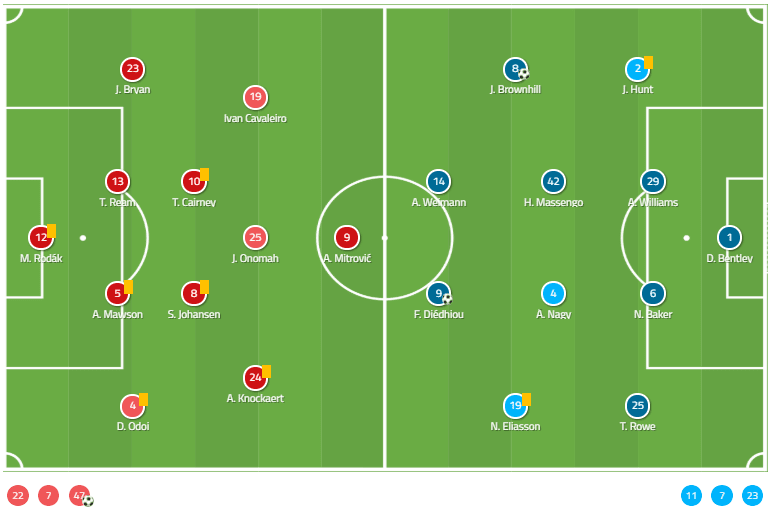
Many expected Bristol City to line up in a 3-5-2 when playing away from home, however, Johnson sprung a surprise when he chose a 4-4-2 formation for his team. Upfront, Benik Afobe was almost certain to miss out from a couple of matches later on, with Andi Weimann stepped into the lineup and paired up with Famara Diédhiou as the team’s leading strikers.
Meanwhile, the former Chelsea duo Jay Dasilva and Tomáš Kalas were still recovering from their respective injuries, which allowed Tommy Rowe and Ashley Williams to start for the side. Nathan Baker managed to shake off his problem with a dead leg in the last match against Huddersfield to join the Welsh defender as centre-backs. Taylor Moore was expected to start alongside them in case Johnson opted to go with a back-three, but he was registered on the bench for this match and enjoyed several minutes on the pitch when he was subbed on for right-back Jack Hunt.
Fulham’s style of play
As the London-based side enjoyed their home advantage in this match, it was no surprise to see them approach the game with high confidence for a positive result. Right from the start of the game, it was clear that their intention was to build their attacks from the backline and attempted to gain control of the majority of possession.
The involvement of the two centre-backs in Alfie Mawson and Tim Ream was crucial for this as they were natural ball-playing defenders who had the ability to pass the ball around the passing block and even progressed it forward to the attackers. Statistically speaking, they enjoyed a good spell in terms of passing with Mawson completed seventeen of his total 23 forward passes while Ream directed 25 out of his total of 28 forward passes towards its destination. Furthermore, with left-back Denis Odoi tended to stay back at times and the same can be said with defensive midfielder Stefan Johansen, they were able to create a passing block inside their half to counter against Bristol City’s high press.
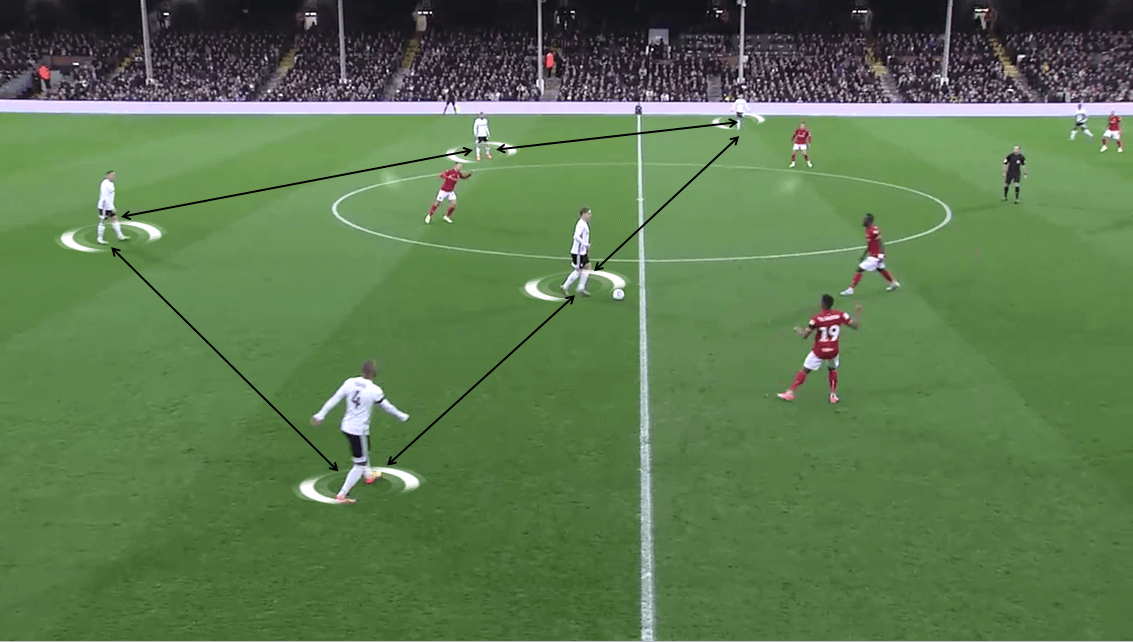
During the build-up process, it was viable for the players who involved in the stage to find the attackers using penetrative passes. With Bristol City opted to form a 4-4-2 defensive shape when they were out of possession, this allowed the Fulham attackers to enter the space behind their defensive lines to receive the ball. Furthermore, another option that they also went with was to make runs in behind their last line.
This responsibility was put on the wingers as they aimed to stretch the opposition’s defensive line to create space centrally. It helped their teammates to attack through the central half of the pitch while also giving the ball carrier two possible passing options out wide. With Anthony Knockaert and Ivan Cavaleiro occupied both flanks, Fulham had two pacey wingers that could turn up at the end of through passes and sprinted towards the 16-yard box. This was also one of the main attacking methods that Fulham implemented during the match since it reduced the team’s build-up time, allowing the attackers to have more time to be precise in their moves.
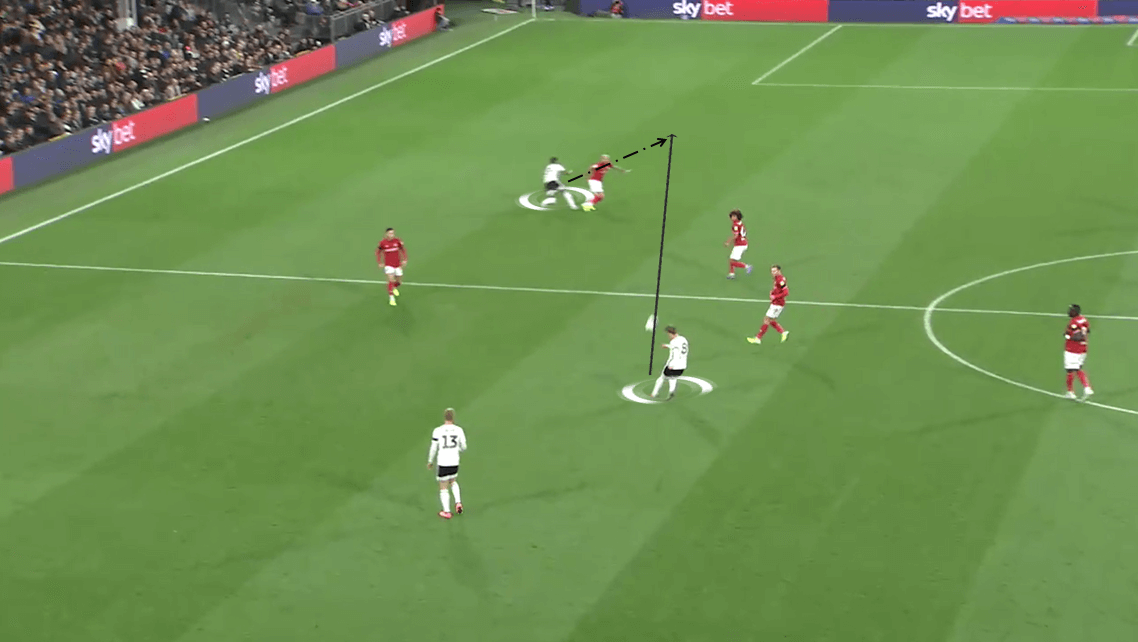
With the emphasis being put on making short and low-risk passes during the build-up, it was no surprise to see Fulham ended up being the superior team in terms of possession, which their stat stood at 66%. In the match, never in a period where the home side registered their ball possession percentage under 60%, which showed how good they were in terms of keeping the ball and forced Bristol City to be on the back foot.
Also, it is quite easy to notice that Fulham were also a wing-oriented team as they had the tendency of distributing the ball down both flanks. Again, using the ability of the wide players, especially left-back Joe Bryan and left-winger Ivan Cavaleiro, they aimed to direct the ball to near the box and laid a cross into the area for Mitrović. It can be seen from the graph below how dangered they were when attacking down the left-hand side, with thirty attacks being created from that side and reached the xG rating of 0.85 xG.
In contrast, though, that 0.85 xG showed the opposite thing when compared with the number of attacks being created. As they had thirty attacks being created from the left-wing, they only managed to head close to one goal, according to the xG rating. This showed the lack of efficiency although the left-wing was their main attacking side. Compared that to the danger level of the attacks being created centrally, it is clear that with a similar xG rating and lower number of attacks, Fulham enjoyed a more successful spell as the efficiency was much higher when they attacked down the central area.
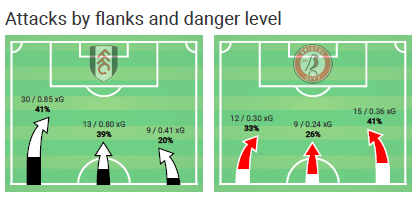
Among the situations that being created down both flanks, two remained as standouts about how they used the combination of a wing-back and a winger to create attacks. Firstly, as the left-winger, either starter Ivan Cavaleiro or substitute Neeskens Kebano tended to stretch Fulham’s attacking shape wide more often, they usually ended up on the edge of the 16-yard box.
This turned them into a potential receiver of the ball in case one of his teammates opted to change the team’s attacking direction. Using a long pass, it was viable to find the winger on the far side of the box and gave him more time and space to execute his move since Bristol City’s defensive shape would need some time to shift their shape across, similar to the situation below that led to Fulham’s only goal of the game.
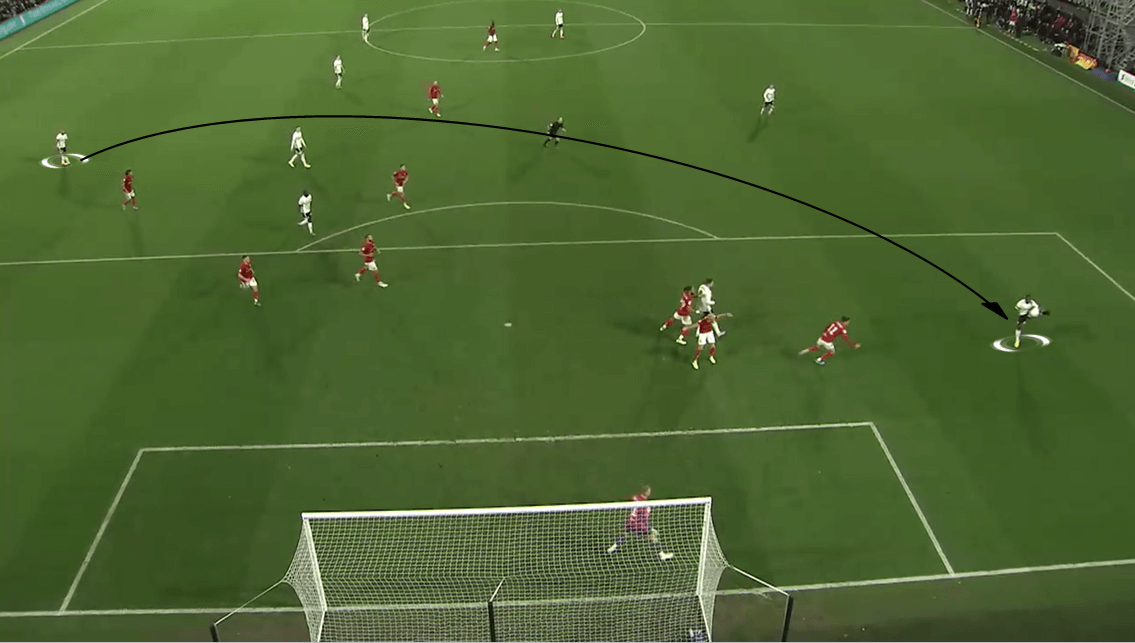
The second one was created directly from the left-hand side which involved the combination between Bryan and Kebano. As the attack seemed to be quite simple, it still demonstrated the principles that Parker implemented in order to help his team to find a goal. The scenario of Bryan linked up with the left-winger to progress the ball down the flank occurred quite often during the match as the former Bristol City left-back tended to overlap and even turned inverted during a few situations. In this situation, he opted to lay the ball towards the winger to allow him to find Mitrović inside the box with a floated cross.
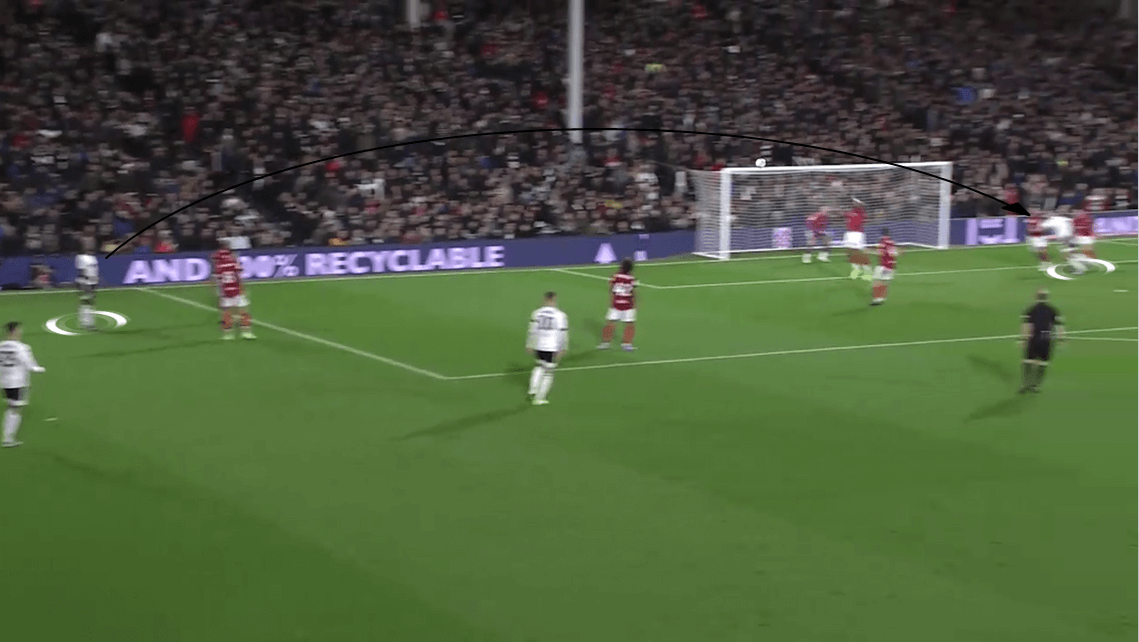
Defensively, the home side tended to press aggressively when they were out of possession. By pushing their formation a bit higher, it created more support for the attackers upfront and allowed them to focus on pressing Bristol City’s defenders. One of the principles that can be seen from their press was they aimed to overload one side of the pitch using three attackers followed three of the opposition’s defenders.
Whenever the ball carrier had the ball, they would swarm the area surrounded him by marking the two nearest passing options while asking for support from Onomah. They aimed to suffocate the opposition by eliminating possible passing lanes up the pitch and created a quick counter-attack towards the opposition’s goal. Although they did manage to execute their plan, Fulham didn’t have much chance to apply pressure on Bristol City players since they opted to move the ball quickly during their build-up process.
As their press was bypassed, the players would quickly retreat into their half and form a 4-3-3 defensive shape in front of the 16-yard box. The last line of the shape, which was created by the defenders, weren’t hesitate in stretching wide to fill in both the central and wide areas. Meanwhile, the three central midfielders opted to stay narrow to create an overload in the central part of the pitch.
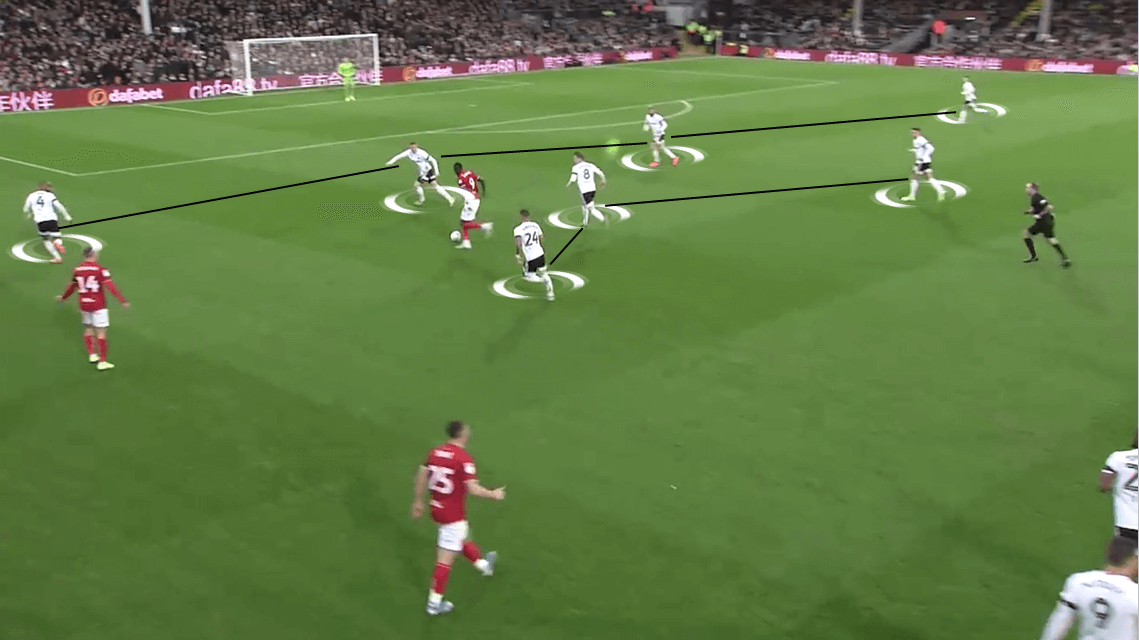
Bristol City’s style of play
Given the fact that Johnson’s side had to play away from home, still, they approached this match with high confidence. It was clearly visible by the way they set up their defensive shape and their active pressing strategy. Firstly, about their press, playing with two strikers gave Bristol City an advantage since Diédhiou and Weimann were able to mark Fulham’s centre-backs and prevented them from making penetrative passes.
Furthermore, both wingers also tended to move higher up the pitch and created a line of four to mark Fulham’s defenders while also isolated them from the rest of the team. In order to progress the ball up the pitch, the defenders had no choice but to make long passes due to the fact that there were pressure being applied on them on a constant basis. Although Fulham did manage to control the ball more often, they usually had to circulate it among the defenders until they found a pocket of space where they could drive the ball into. It happened often during the first period of the match but then started to decrease over time.
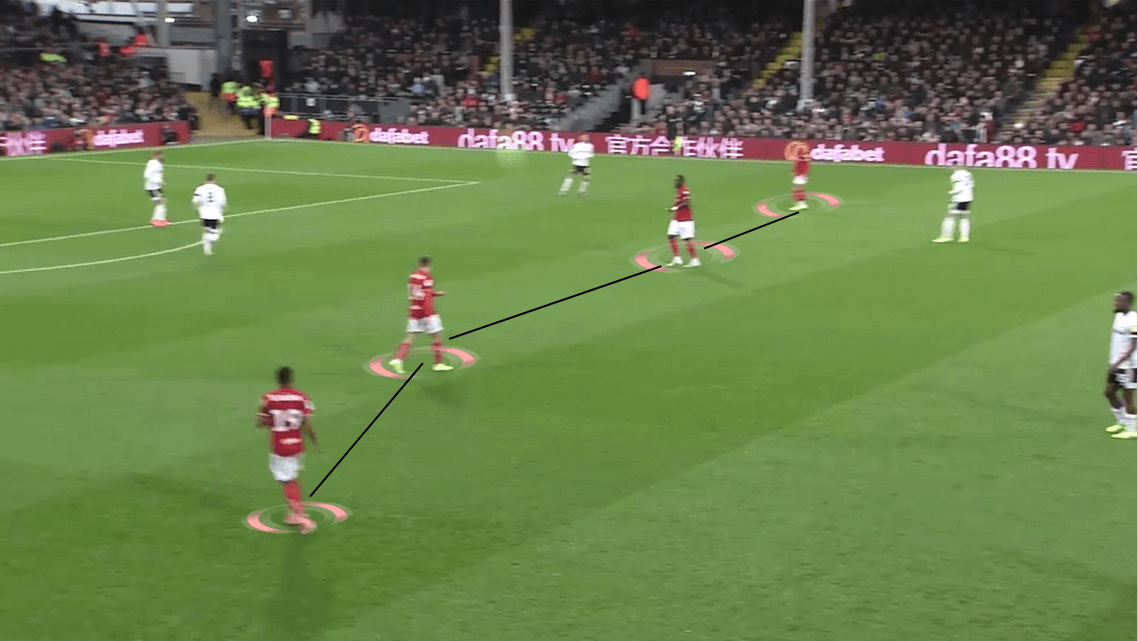
Inside their half, Bristol City aimed to create a 4-4-2 defensive juggernaut in front of Daniel Bentley’s box. With Bristol City players opted to widen the distance between each player, it was possible for the visitor to keep the wide-area in control as well as prevented Fulham from distributing the ball in between the lines. This was one of the factors that led to Fulham’s struggling day in terms of creating chances towards Bentley’s goal as their midfielders had little choice to progress the ball into the final third, therefore, unable to link up with the attackers.
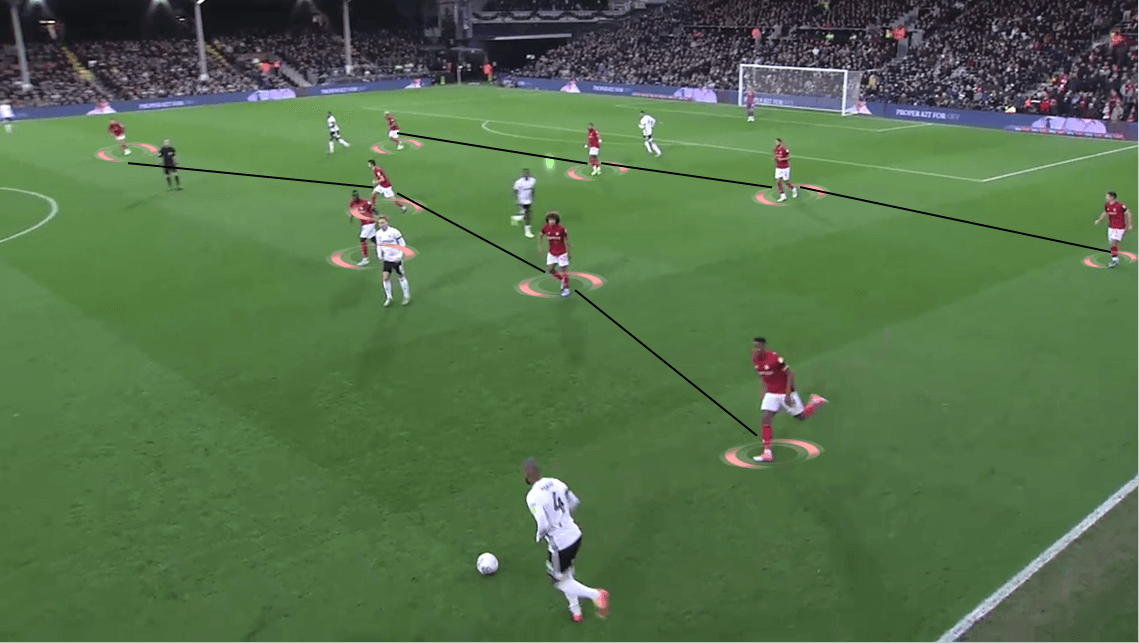
Still, the fact that Bristol City did enjoy a decent day with their 4-4-2 defensive shape doesn’t cover up several problems that they had during the match. During the team’s press, it was required that the defensive line should be positioned high up the pitch. Besides the involvement of the attackers, both wing-backs also pushed up several times, which left Nathan Baker and Ashley Williams vulnerable when they defended against Fulham’s counter-attack.
Apart from being able to distribute the ball down both flanks, Fulham were also dangerous in quick breaks thanks to the ability of their wingers. Anthony Knockaert was the player that really caught the eyes with his positioning and how he linked up with the midfielders. Starting off as a right-winger, but he usually tucked inside more often and at times, even worked inside the central half of the pitch alongside Mitrović. While the Serbian international or a teammate of his received the ball, he would use his pace to escape his marker and offer to pick the ball up, similar to the shot below.
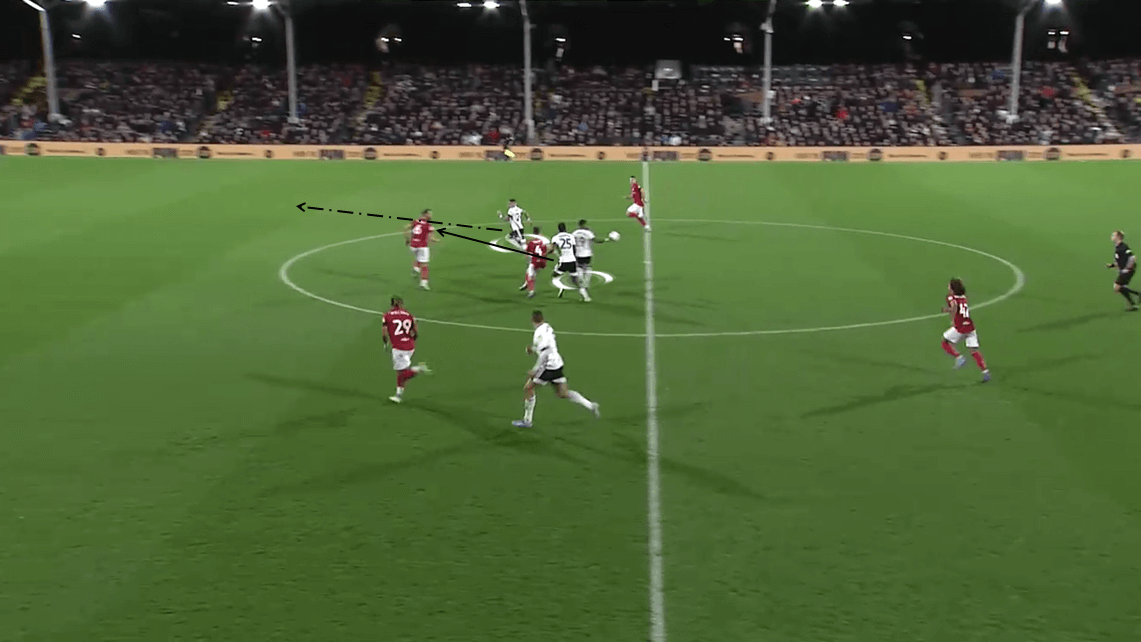
Offensively, Bristol City were efficient in terms of creating chances and converting them. As the xG graph below shows, their xG rating inside both halves always came close to one goal and it contributed heavily to their total of 1.81, which was closed to two goals. Amid the fact that they didn’t have such good numbers as Fulham’s, but it were divided equally, which showed the consistency of their attack as the visitor aimed to maintain that level in order to find those decisive goals.
It is fair to say that they didn’t overperform the numbers, although they still needed 0.19 xG more to reach the 2 xG mark. The player who played a crucial role in their attack for this match was Diédhiou as he registered 1.23 xG, the highest number among the players involved in the match from both sides.

Being deployed as a target man in Johnson’s 4-4-2 formation, the former Angers striker usually used his physicality to receive long passes and then shielded it for his teammates who attempted to continue their run towards Fulham’s 16-yard box. At the same time, he also had the pace that helped him got past his markers to open up space for his next move.
Inside the box, he was a significant threat due to his height (6’3”- 1m92) and it gained him a huge advantage in terms of turning up at the end of crosses. In the situation below, notice the positioning that allowed him to receive Niclas Eliasson’s cross. With three Fulham defenders who positioned near the 6-yard box, he moved slightly away from them as he noticed space was being left as the home side’s players were retreating into the box. Without any significant pressure being put on him, he was able to make a good jump to receive the ball and made a thumping header towards Marek Rodák’s position.
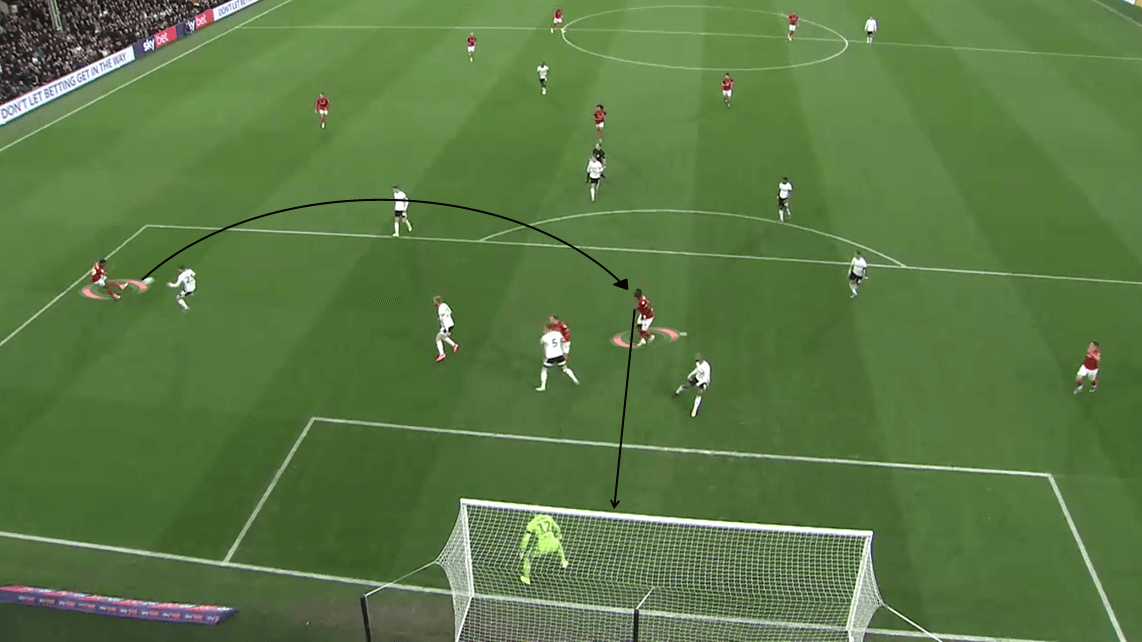
Conclusion
As expected, the match proved to be a great tactical clash between Parker and Johnson as both teams constantly matched each other on the field. With both Fulham and Bristol City were enjoyed a good position on the league table, they even had more momentum to push for three points and it made the match more fascinating to watch as they increased their tempo right from the start.
Still, at the end of the day, only one team managed to do so and it was Bristol City. By being disciplined in defence with a 4-4-2 formation and played as a wing-oriented team, they maximised what they have done best during the last few games to help them secure three points. For Fulham, there will be a lot to do after this match if they want to stay in the promotion race amid the fact that they had a decent match after all. With three points now went back to Ashton Gate with Bristol City, the race will become tougher matchday by matchday and it will be a sign for more to come.

If you love tactical analysis, then you’ll love the digital magazines from totalfootballanalysis.com – a guaranteed 100+ pages of pure tactical analysis covering topics from the Premier League, Serie A, La Liga, Bundesliga and many, many more. Buy your copy of the December issue for just ₤4.99 here





Comments